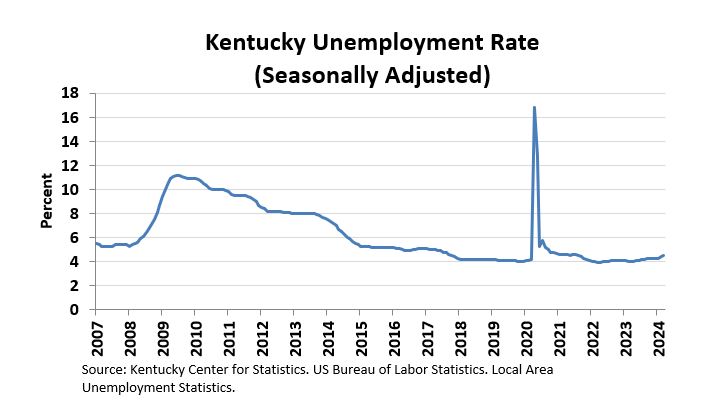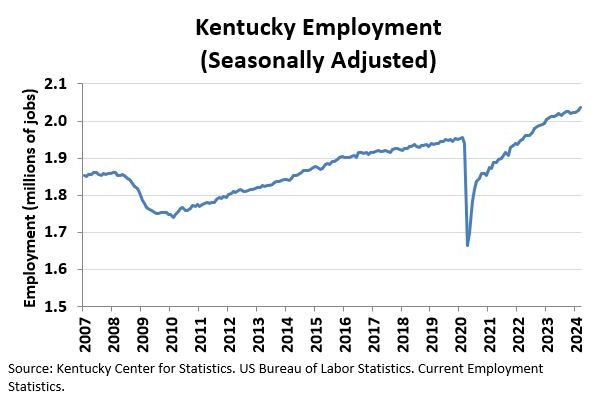 FRANKFORT, Ky. — Kentucky’s seasonally adjusted preliminary March 2024 jobless rate was 4.5%, according to the Kentucky Center for Statistics (KYSTATS), an agency within the Kentucky Education and Labor Cabinet.
FRANKFORT, Ky. — Kentucky’s seasonally adjusted preliminary March 2024 jobless rate was 4.5%, according to the Kentucky Center for Statistics (KYSTATS), an agency within the Kentucky Education and Labor Cabinet.
The preliminary March 2024 jobless rate was up 0.1 percentage points from February 2024 and up 0.5 percentage point from one year ago.
The U.S. seasonally adjusted jobless rate for March 2024 was 3.8%, which was down from the 3.9% recorded for February 2024, according to the U.S. Department of Labor.
Labor force statistics, including the unemployment rate, are based upon estimates from the Current Population Survey of households. The survey is designed to measure trends in the number of people working and includes jobs in agriculture and individuals who are self-employed.
Kentucky’s civilian labor force was 2,027,717 in March 2024, an increase of 3,147 individuals from February 2024. The number of people employed in March increased by 1,145 to 1,937,129 while the number unemployed increased by 2,002 to 90,588.
 “Kentucky’s unemployment rate increased to 4.5% in March as workers returned to the labor force,” said University of Kentucky’s Center for Business and Economic Research (CBER) Director Mike Clark, Ph.D. “The increase in the labor force represents only one month but does reverse the gradual decline Kentucky has experienced over the past few months.”
“Kentucky’s unemployment rate increased to 4.5% in March as workers returned to the labor force,” said University of Kentucky’s Center for Business and Economic Research (CBER) Director Mike Clark, Ph.D. “The increase in the labor force represents only one month but does reverse the gradual decline Kentucky has experienced over the past few months.”
In a separate federal survey of business establishments that excludes jobs in agriculture and people who are self-employed, Kentucky’s seasonally adjusted nonfarm employment increased by 9,400 jobs to 2,036,900 in March 2024 compared to February 2024. Kentucky’s nonfarm employment was up 25,000 jobs or 1.2% compared to March 2023.
“In March, Kentucky posted its strongest month to month employment gains since early 2023,” said Clark. “While the professional and business services saw the largest increase in employment, the gains were widespread with most of Kentucky’s major sectors reporting higher levels of employment.”
Nonfarm data is provided by the Bureau of Labor Statistics’ Current Employment Statistics program. According to the survey, the jobless rate improved for nine of Kentucky’s major nonfarm North American Industry Classification System (NAICS) job sectors in March 2024, decreased for one, and was unchanged for one.
Employment in Kentucky’s professional and business services sector jumped by 2,600 jobs or 1.1% in March 2024. From February to March, employment increased by 600 jobs in the professional, scientific and technical services subsector; 100 jobs in the management of companies subsector; and by 1,900 jobs in the administrative, support and waste management subsector. The sector has decreased by 100 positions since March 2023.
The educational and health services sector grew by 1,800 positions in March 2024. Employment in the health care and social assistance subsector increased by 1,500 jobs from February to March. The educational services subsector gained 300 jobs. Since last March, this sector has grown by 12,300 jobs or 4.1%.
The leisure and hospitality sector bounced back in March, adding 1,800 positions. This represents a gain of 0.9%. This sector reported 3,800 more jobs in March than one year ago. The accommodations and food services subsector was up by 1,200 positions in March. The arts, entertainment and recreation subsector gained 600 jobs from February to March.
Construction employment was up 1,200 jobs or 1.3% from February 2024 to March 2024 and up 3,900 positions or 4.4% from one year ago.
“Kentucky’s construction firms continued to add workers in March, suggesting Kentucky is experiencing strong demand for construction projects,” said Clark.
Kentucky’s financial activities sector increased by 700 positions from February 2024 to March 2024 but was down 1,300 jobs from March 2023. The finance and insurance subsector added 400 jobs while the real estate, rental and leasing subsector added 300 positions.
Employment in the trade, transportation and utilities sector rose by 600 positions from February to March but was down 1,200 jobs or 0.3% compared to a year ago. Among the subsectors, wholesale trade lost 100 jobs and transportation, warehousing and utilities lost 700 jobs. These losses were more than offset by a gain of 1,400 jobs in the retail trade subsector.
Kentucky’s manufacturing sector expanded by 500 jobs from February 2024 to March 2024. The durable goods manufacturing subsector increased by 200 positions and the non-durable goods subsector added 300 jobs. Kentucky’s manufacturing employment was down 700 positions or 0.3% compared to March 2023.
Employment in the government sector increased by 300 jobs from February 2024 to March 2024. The number of jobs rose by 200 in federal government; was unchanged in state government; and increased by 100 in local government. The total number of government jobs rose by 7,500 positions or 2.5% compared to March 2023.
The other services sector was up by 200 jobs from February to March. This sector had 1,300 more positions in March 2024 compared to March 2023. This sector includes repairs and maintenance, personal care services and religious organizations.
The number of jobs in the state’s mining and logging sector was unchanged from February to March. This sector had 200 more jobs in March 2024 compared to March 2023.
Employment in Kentucky’s information services sector fell by 300 jobs from February to March. The industries in this sector include traditional publishing as well as software publishing; motion pictures and broadcasting; and telecommunications. The number of jobs in this sector was down 700 from one year ago.
Civilian labor force statistics include nonmilitary workers and unemployed Kentuckians who are actively seeking work. They do not include jobless Kentuckians who have not looked for employment within the past four weeks.
Kentucky’s statewide jobless rate and employment levels are seasonally adjusted. Employment statistics undergo sharp fluctuations due to seasonal events, such as weather changes, harvests, holidays, and school openings and closings. Seasonal adjustments eliminate these influences and make it easier to observe statistical trends. However, due to the small sample size, county unemployment rates are not seasonally adjusted.
Visit the Kentucky Center for Statistics website to learn more about Kentucky labor market information.



















